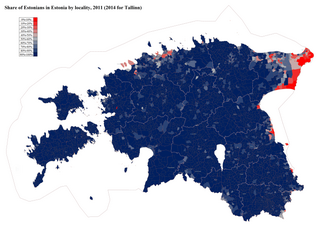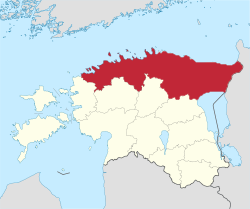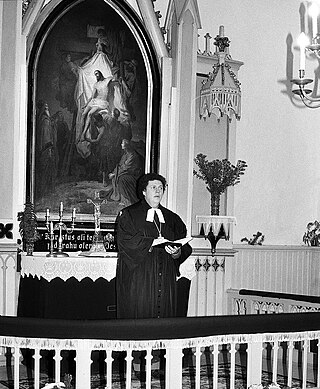Related Research Articles

Ida-Viru County is one of 15 counties of Estonia. It is the most north-eastern part of the country. The county contains large deposits of oil shale - the main mineral mined in Estonia. Oil shale is used in the production of shale oil and in thermal power plants. The capital of the county is the town of Jõhvi which is administratively united with the Jõhvi Parish; nevertheless, Narva is the largest town in the county in terms of population and at the same time the third largest city in Estonia after Tallinn and Tartu.

Kohtla-Järve is a city and municipality in northeastern Estonia, founded in 1924 and incorporated as a town in 1946. The city is highly industrial, and is both a processor of oil shales and is a large producer of various petrochemical products. During the 1944–1991 Soviet occupation, large numbers of immigrant workers from Russia and other parts of the former USSR were brought in to populate the rapidly growing city. The population in the Kohtla-Järve area which had been, as of 1934 census, over 90% ethnic Estonian, became overwhelmingly non-Estonian in the second half of the 20th century. According to more recent data 21% of the city's population are ethnic Estonians; most of the rest are Russians. Kohtla-Järve is the fifth-largest city in Estonia in terms of population.

Meistriliiga is the highest division of the Estonian Football Association annual football championship. The league was founded in 1992, and was initially semi-professional with amateur clubs allowed to compete. With the help of solidarity mechanisms, the league is fully professional since the 2020 season.

In Estonia, the population of ethnic Russians is estimated at 306,801, most of whom live in the capital city Tallinn and other urban areas of Harju and Ida-Viru counties. While a small settlement of Russian Old Believers on the coast of Lake Peipus has an over 300-year long history, the large majority of the ethnic Russian population in the country originates from the immigration from Russia and other parts of the former USSR during the 1944–1991 Soviet occupation of Estonia.
The Communist Party of Estonia (CPSU) (Estonian: Eestimaa Kommunistlik Partei; Russian: Коммунистическая партия Эстонии, romanized: Kommunisticheskaya partiya Estonii) was a political party in Estonia. The party was initially known as Communist Party of Estonia (on CPSU platform) (EKP (NLKP platvormil)), and was formed in 1990 through a split in the original Communist Party of Estonia (EKP). The split occurred at the 20th congress of EKP in March 1990, as a reaction against the decision of the congress to separate EKP from the Communist Party of the Soviet Union and rebrand itself into the Estonian Democratic Labour Party (EDTP). Immediately after the independence decision of EKP, the pro-Soviet delegates left the congress venue. The convened their own rival 20th congress on March 26, 1990. EKP (NLKP platvormil) elected its own Central Committee, headed by its First Secretary Alexander Gusev, and would function as a separate party from EKP.
The coats of arms of the 15 counties of Estonia are presented below.

The following is an alphabetical list of articles related to the Republic of Estonia.

Northern Estonia is a geographical region of Estonia, consisting of the three northernmost counties - Harju County, Ida-Viru County and Lääne-Viru County. The largest towns of Northern Estonia are Tallinn, Narva, Kohtla-Järve and Rakvere. Northern Estonia is the most populous area in Estonia, with 60.3% of the population living there.
The Meistriliiga (EML), also known as the Coolbet Hokiliiga for sponsorship reasons, is the top-tier ice hockey league in Estonia. The league consists of five teams from Estonia and two teams from Latvia.
The 2015–16 Estonian Cup was the 26th season of the Estonian main domestic football knockout tournament. The cup holders, Nõmme Kalju, were knocked out in the Quarter-Finals by Sillamäe Kalev. Flora won their seventh title after defeating JK Sillamäe Kalev 3–0 in the final.
The 2016 Estonian Football Winter Tournament or the 2016 EJL Jalgpallihalli Turniir is the third edition of the annual tournament in Estonia. This tournament is divided into three groups of 6 teams.
The 2017–18 Estonian Cup was the 28th season of the Estonian main domestic football knockout tournament. FCI Levadia won their ninth title after defeating Flora in the final.
The 2018–19 Estonian Cup was the 29th season of the Estonian main domestic football knockout tournament. Narva Trans won their second title after defeating Nõmme Kalju in the final and qualified for the first qualifying round of the UEFA Europa League.

Illar Hallaste was an Estonian cleric, politician, lawyer, and businessman, most notable for being a voter for the Estonian restoration of Independence.
United Methodist Church in Estonia is a Methodist church organisation in Estonia. It is an independent church that belongs regionally to the Northern Europe and Eurasia Central Conference of the United Methodist Church and to the United Methodist Church Nordic and Baltic Episcopal Area. On the world level it is a member of the World Methodist Council.
This page summarizes Estonian football in 2020. It contains information about the league system, national teams, beach football and futsal. On 13 March 2020, football was suspended in Estonia due to the COVID-19 pandemic. Meistriliiga was resumed on 19 May and Esiliiga and Esiliiga B were continued a week later.
The 2020–21 Estonian Cup was the 31st season of the Estonian main domestic football knockout tournament. FCI Levadia won their tenth title, and qualified for the 2021–22 UEFA Europa Conference League.
References
- ↑ Dieter Nohlen & Philip Stöver (2010) Elections in Europe: A data handbook, p574 ISBN 978-3-8329-5609-7
- ↑ Silver, Brian D.; Titma, Mikk (1996). "Support for an Independent Estonia". International Journal of Sociology. 26 (2): 3–24. doi:10.1080/15579336.1996.11770136. JSTOR 20628474.
- ↑ Payerhin, Marek (2016-09-02). Nordic, Central, and Southeastern Europe 2016-2017. Rowman & Littlefield. p. 135. ISBN 9781475828979.
- ↑ Eesti NSV / Eesti Vabariigi Ülemnõukogu XII koosseis. Eesti Rahvusraamatukogu, 29.03.1990–29.09.1992. Tallinn, 2013
- 1 2 Grofman, Bernard; Mikkel, Evald; Taagepera, Rein (1999). "Electoral systems change in Estonia, 1989–1993". Journal of Baltic Studies. 30 (3): 227–249. doi:10.1080/01629779900000081. S2CID 143812929.
- 1 2 Núñez, Lidia; Jaakson, Lauri. "Electoral System Change in Europe since 1945: Estonia" (PDF). Electoral System Change in Europe Since 1945.
- ↑ "Elections and Referendums in Estonia 1989-1999". Estonian National Electoral Committee. 2008-11-17.